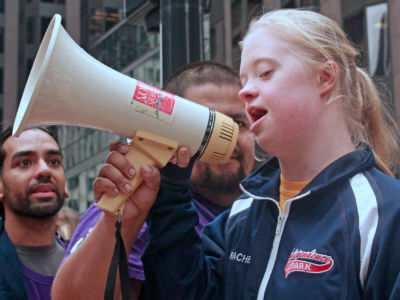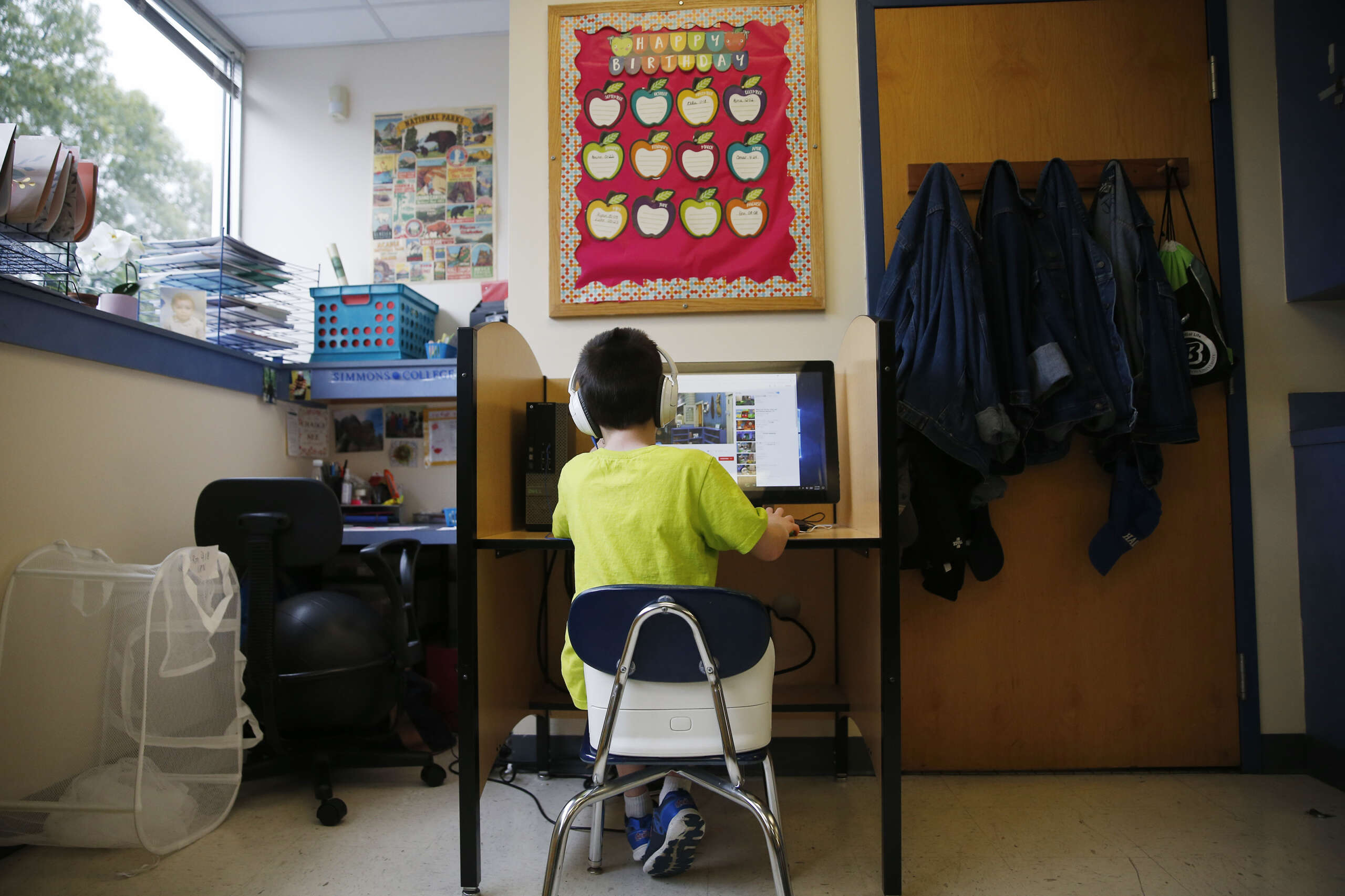When Emilio Bernier was born in May 2016, doctors told his parents, Hilda and Olivier, that their son had Down syndrome. As a toddler, Emilio received speech, occupational and physical therapy, but it was difficult to find a kindergarten where he could study alongside children without disabilities. The frustrations the family experienced, including the rigid bureaucracy of intransigent school administrators, are the subject of Olivier’s feature film, “Forget Me Not.”
Emilio’s story is, at least for now, a relatively happy one. He’s enrolled in a mainstream kindergarten class at his suburban New Jersey public school, where he plays and learns with his peers, and he receives supplemental therapy. Hilda and Olivier say he is thriving.
But Emilio faces many obstacles to getting the education he is legally entitled to, and he is not alone.
According to the government-run National Center for Education Statistics, 15% of students enrolled at the start of the 2020-2021 school year, or 7.2 million children, had been diagnosed with a disability. But while most children with physical disabilities or specific learning disabilities spend the majority of their school day in mainstream classrooms, only 19% of children with intellectual and developmental disabilities (IDD) — like Emilio — spend the majority of their day in mainstream education.
Predictably, this has dire consequences, with only 40 percent of children with IDD graduating from high school and only 15 percent of the 6.5 million U.S. residents with IDD finding work as adults.
Related

Students with disabilities, their families, and teachers want inclusive classrooms with better supports for teachers.
This is despite the fact that for the past 47 years, the Individuals with Disabilities Education Act (IDEA) has committed to providing children with disabilities with a free, publicly funded, appropriate public education in the least restrictive environment possible.
And herein lies at least one problem with inclusive education: Although IDEA stipulates that the least restrictive environment reflects the legal preference of educating students with disabilities in regular classrooms with appropriate aids and supports, schools routinely ignore these recommendations and house students with cognitive delays in segregated settings.
The Crane Center for Early Childhood Research and Policy at Ohio State University states, “For the past 40 years, most children with intellectual disabilities have been educated in classrooms where they spend little time each year with their non-disabled classmates. Moreover, there is evidence that factors other than the severity and nature of a child’s disability are driving these trends.”
Denise S. Marshall, CEO of the Council of Parent Lawyers and Advocates, a national organization that works to protect the legal and civil rights of students with disabilities and their families, blames this on ableism. “At the heart of civil rights and equality is the idea that separate does not mean equal,” Marshall told Truthout. “Inclusive schools value diversity within the classroom and seek to foster a sense of community so all students can learn and grow. When schools pull children out of the general education environment and put them in more restrictive special education classes, they increase physical restraints and isolation. Children with intellectual disabilities are at greatest risk for physical restraint and isolation.”
Jordyn Zimmerman, director of professional development for The Nora Project, an organization that helps educators develop curriculum that meets the diverse needs of all students, knows firsthand the trauma this can cause. Zimmerman, who has autism and cannot speak, communicates using an iPad that “speaks” what she types into words.
“I’ve had an iPad for nine years,” Zimmerman, 27, told Truthout. “It took a lot of support from my parents and a lot of persistence on my part to get it.” Before she got her life-changing device, Zimmerman said she was deemed intellectually disabled and sent to both local public schools and segregated schools far from her hometown of Hudson, Ohio. During her time in public school, she was physically abused, including being handcuffed by police for being abusive.
Being underestimated was extremely frustrating, she explains. “I was always trying to understand the world around me,” she says. “Speaking is a motor action. Language is a cognitive function. They are often confused, to the detriment of students who can’t speak.”
Her experience in high school, she says, illustrates the results of this confusion: She describes how she was rarely given any work beyond odd jobs like alphabetizing business cards, washing windows at the local bus stop, and hanging clothes up at a department store. Her teachers, she explains, assumed she would only understand the most basic of instructions.
“I was fortunate to eventually have access to technology, but my students shouldn’t have to rely on luck to participate,” Zimmerman said. “People are denied access to technology every day,” leaving approximately 5 million non-verbal children and adults without the augmentative and alternative communication devices they need to fully participate in school, family and community life.
Zimmerman now has a master’s degree in education and works full time to promote educational equity.
“Inclusion allows people to belong in a space that is meaningful, which is better for everyone in terms of school grades, mental health, and other indicators of learning success,” she says. “As assistive technology specialist Erin Sheldon points out, inclusion is also safer: being in a classroom with 30 classmates who know what’s going on and can speak up if something’s wrong is better than being in a room with three classmates you may not be able to communicate with.”
Other benefits of inclusive education are well documented. Students with disabilities who attend inclusive classes perform better in math and reading than their segregated peers. They also have higher self-esteem, greater social interactions and friendships, and better communication and social skills. Children without disabilities also benefit, becoming more tolerant and respectful of human diversity.
Filmmaker Dan Habib, director of the Inclusive Communities Project at the Westchester Human Development Institute, and his son Samuel, who has cerebral palsy, have been working to promote inclusion for more than 20 years, making films that give people with disabilities a platform to talk about their lives and experiences.
Both Dan and Samuel believe inclusion is a matter of will. “It’s an attitude,” Dan told Truthout. “Schools in Mississippi and on Native American reservations have done well with inclusion, even though 100% of the students are poor. It’s not about money, it’s about leadership. Unfortunately, there’s a lot of inconsistency, and inclusion can vary by city, school, and teacher.” Additionally, he acknowledges that there is still a lot of prejudice against people with disabilities, and he hopes that teacher training programs will help eliminate it. The goal, he says, should be to eliminate prejudice against people with disabilities while simultaneously emphasizing the benefits of inclusion for everyone in the community, regardless of health status.
“Teacher training has improved, and some universities no longer treat general education and special education separately,” he says. “In these programs, aspiring teachers learn to teach all children, but this is still not enough. Segregated structures have been in place for more than 80 years, and some struggle to reinvent the system. Many schools simply take the path of least resistance, which means maintaining segregation and putting children with disabilities in the same classrooms. This does not provide a truly representative education in the real world.”
Dan says parents also need to be educated to question what they are told by assessors and education authorities: “A lot of parents assume that schools are running their children’s best interests and they believe what they’re told, but they shouldn’t.”
In addition, teachers and school administrators should include children and teens with disabilities in discussions about educational goals and how best to achieve them.
“Teachers need to learn directly from people with disabilities, not just rely on research studies and textbooks,” Emily Radau, author of Demystifying Disability: What to Know, What to Say, and How to Be an Ally, told Truthout. “They need to hear about lived experiences.”
Lorenzo Van Ness, a disability justice trainer with Sins Invalid, a disability justice performance project centered on disabled artists of color and queer/gender non-conforming people, and a special education graduate student at Hunter College in New York City, agrees, arguing that more needs to be done to prepare teachers to understand disability and how biases against people with disabilities have been perpetuated.
“The American education system was born out of a desire to assimilate new immigrants and reduce child labor,” Van Ness says. “At the same time, public schools were built around the idea of industrial standardization and mass production. As a result, some people were seen only in traditional terms of productivity and were deemed ‘less valuable’ than others. Prejudice against them was a direct result of this mindset.”
As Habib pointed out, changing this usually comes down to who is in charge of public education.
“School principals are key to setting the tone,” Carol Quirke, CEO of the Maryland Coalition for Inclusive Education, told Truthout. “The second most important thing is collaboration. Teachers need time to plan and coordinate with other teachers.”
And then there are the parents and guardians of children with disabilities, whose expertise is often undervalued by teachers and school administrators. “Tests are not the only way to identify the basic problems of a particular child,” says Olivier Bernier. “Schools need to look at their systems and see what prejudices still persist so that they can address those that think that children with intellectual or developmental disabilities cannot learn with others or will perform worse in class. Schools also need to acknowledge that there is no such thing as an ‘average’ student. Everyone has some learning challenges.”
“We all have to buy into inclusive education,” adds Hilda Bernier, “but it only takes one person who believes in the benefits of inclusive education to start it in a particular school. I am hopeful that things are moving in that direction. When teachers realise they can teach all kinds of students, all kinds of minds, it opens the door to an education that benefits everyone. I look forward to the day when instead of talking about inclusive education, we talk about education, knowing that education is a classroom where everyone learns together. We must not be afraid to embrace change.”
Copyright © Truthout. May not be reproduced without permission.
Source link

